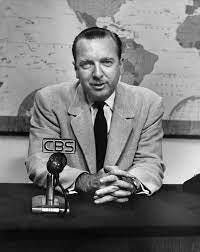Some of that Good-Old Historical Background
In 1949, the Federal Communications Commission (FCC) put into place something called “The Fairness Doctrine.” (I can assure you, this is NOT anything Trump wants to take us backward to in his quest to make America “great” again.) It was a policy that required any holder of a broadcast license to do two basic things when it came to presenting the news.
1) Devote some airtime to the discussion of controversial issues that are in the public interest—that is, matters that contribute to the welfare or well-being of the general public.
2) Air contrasting views concerning those controversial issues.
I know. Wow. Different time, different planet.
Television stations (the very few of them back in the day) and radio stations had wide latitude when it came to enacting these two basic requirements. The doctrine did not require equal time for opposing viewpoints, and contrasting views could be presented in any number of ways. Nevertheless, a fair and balanced treatment was mandatory when it came to covering the news.
So, yeah, the original slogan of the Fox News Channel, “Fair and Balanced,” seems to be some combination of irony, bullshit, and Roger Ailes thumbing his nose at the FCC.
The Fairness Doctrine met its doom at the hands of Ronald Reagan. No surprise there. He and his neoliberal pals mounted an assault on the policy that resulted in its being dropped by the FCC in 1987. Members of Congress called the decision to abandon the policy “wrongheaded, misguided, and illogical.” They passed a bill in an attempt to codify the doctrine into law.
Reagan vetoed that bill.
A second attempt to bring back the Fairness Doctrine took place in 1991. This time it was George H. W. Bush—with his own pack of neoliberal cronies—who killed the bill by threatening another veto. Thus died Fairness in American news broadcasting. The doctrine remained on the Federal Register as a meaningless survival until 2011, when the FCC finally removed the rule that implemented the policy.
The eradication of this FCC rule often is identified as a key factor in the ever-increasing level of political polarization in the U.S.
That’s a big Duh.
Concurrent with the fall of the Fairness Doctrine was the rise of cable TV in the 1980s and early 1990s. Cable news programs often pay no attention whatever to fair and balanced coverage of current events. Since then, another obvious and major contributing factor to our news woes is social media. As social media—in all its many forms—has blown up, so too has truth-in-reporting—even the merest pretense of it—been blown out of the water.
As a result, what we experience now as our “news” landscape is, in fact, a hellish minefield of lies, stupidity, scams, conspiracy theories, A.I. trickery, and ever more newly invented forms of utter nonsense. While a lot of this nonsense is amateurish crap, a lot of it is extremely well-funded crap. Crap that features cutting-edge technology and high production value. In other words, nonsensical crap that’s hard to resist.
In short, what we currently face is the greatest Bonzo Bullshit Fest humanity has ever created for itself.
From this:
To this:
If you’d like to steep yourself in an academic study of this issue (and who doesn’t?), take a look at Saving the News: Why the Constitution Calls for Government Action to Preserve Freedom of Speech (2021) by Martha Minow of Harvard Law School.
If you’d like an easier to digest but nonetheless actually fair and balanced introduction to this issue (very tempting), take a look at the 12-minute TV segment “Exploring the links between political polarization and declining trust in news media” (aired 31 July 2024) by Judy Woodruff of the PBS News Hour.
Opinion Media vs. News Media
What often takes the place of fair-minded and accurate news coverage in America is opinion journalism carried out by way of narrowcasting.
Opinion journalism is a form of news-like commentary that makes no claim to objectivity. In many cases, the reader or viewer is well aware that a subjective point of view is being expressed. Editorials, op-eds, political cartoons, and obvious punditry are all examples of such journalism. The point of these pieces is to express and promote a particular viewpoint for a specific social or political purpose.
Now, let’s be clear. Opinion journalism is just fine when the consumer of it is aware that it is, in fact, opinion journalism. What’s happening more and more, however, is that people are consuming opinion journalism thinking that it’s news journalism (you know, the fair and balanced kind). And while certainly a good deal of the blame for this mistake belongs to naïve audiences, a whole lot of the blame rests as well with the makers of today’s opinion journalism.
Two obvious examples are Fox News and MSNBC—polar opposites on the social and political opinion gamut in America. In the spirit of full disclosure, I agree with a great majority of viewpoints expressed on MSNBC. Likewise, I can’t think of a single viewpoint I’ve ever heard on Fox News that I even remotely agree with. Nonetheless, I know that they are both sources of opinion journalism.
What’s concerning, though, is that both of these opinion media outlets look, feel, and act like news media outlets. Their format, their studio look, and their talking heads all look quite official, feel entirely Newsy, and act in a wholly trustworthy manner. Yet they are dishing out opinions in the pursuit of a specific social-political agenda, not discussing a range of controversial issues in the public interest. Moreover, only occasionally—and only when it’s to their advantage—do these networks present contrasting views concerning those issues.
In other words, neither Fox News nor MSNBC follow the Fairness Doctrine.
Probably because I think the political positions advocated on Fox News are, well, abhorrent, I readily see through their faux-journalistic masquerade. (See my Rants: Need One More Reason to Dislike Tucker Carlson? (Part 1) and Need One More Reason to Dislike Tucker Carlson? (Part 2)). Fox News also is notorious for telling outright lies to viewers. (See Network of Lies (2023) by Brian Stelter and “Brian Stelter discusses ‘Network of Lies’ and how Fox maintains its brand” (aired 16 November 2023) by Amna Nawaz of the PBS News Hour.)
In the spirit of not mincing works, I think that Fox News is a cankerous carbuncle on the keister of American news broadcasting. And it’s not even the worst and most outrageous rightwing “news source” out there. It’s just the most popular and widespread—and therefore the most threatening to the democratic notion of an informed public.
And whereas I don’t see MSNBC lying outright about the facts of our existence, I do see them spinning those facts ever in a progressive, leftwing direction. And while I very much sympathize with and am pleased to hear such spin, I am equally aware that I am being spun. And it can get tiresome. This leads us to the idea of narrowcasting.
Narrowcasting is the opposite of broadcasting. It’s the practice of aiming a media outlet at a very specific and specialized audience. Not at the public-at-large. The strategy took off in the 1980s and 1990s as cable TV grew in reach and popularity. A good early example of narrowcasting is the cable station MTV (Music Television, 1981) airing music videos presented by video jockeys. Obviously not everyone’s cup of tea, MTV was aimed at the youth market.
When it comes to news programming, the same narrowcasting principle and history applies. As cable TV started to boom, specialized news networks began to appear. An early pioneer was CNN in 1980. Both Fox News and MSNBC came into being in 1996. Before cable TV, there were only three broadcast networks in America (CBS, NBC, ABC). Their newscasting was obviously aimed at the general public and adhered to the Fairness Doctrine. In the new media environment of cable, however, specialized news tailored to a specialized consumer became the dominant business model. These cable news networks also needed a lot of content. They had a lot of time to fill. This filler programming often came in the form of pundit shows. Thus the late 20th century saw the perfect storm for the rise of opinion media.
The new media circus in America has only intensified in the 21st century. The expansion of the internet and the escalation of social media has greatly multiplied the ways that people can get their “news.” (User Alert: if you’re getting your news via X (aka Twitter) you’re basically checking your brain at the portal.) What is more, things such as single-issue platforms, podcasts, online communities, user interaction, and more has made narrowcasting practically the only game in town.
And make no mistake. The sole purpose of narrowcasting is to steer audiences, by any means necessary, in the direction of the narrowcaster’s social and political worldview.
A Cautionary Tale!
In the spirit of total honesty, I myself have fallen victim to the siren’s song of narrowcasting. Since Trump was elected in 2016, I’ve overindulged in watching MSNBC in the evening. I think listening to their progressive sweet nothings whispered into my ear has helped me cope. It’s been one way to offset some of the chaos, abject stupidity, and End Times feel of the Trump era.
Recently, however, I’ve realized that the constant and exclusive pounding of the counter-MAGA drums by Rachel Maddow et al.—as much as I enjoy hearing what these opinion journalists have to say—was doing two detrimental things to me. One, making me more angry and despairing about the disaster of Trump and his ilk. Two, cutting me off from a whole lot of other news that’s going on around the world.
That’s right, MSNBC was making me narrow.
Accordingly, I’ve adjusted my news consumption. I’ve always listened to NPR (National Public Radio) in the morning and whenever driving in a car. But in the evening now, instead of MSNBC, I watch the news programming on PBS (Public Broadcasting Service).
First up is half an hour of DW News, that is, global news broadcast in English by German public and state-owned TV. Then there’s half an hour of BBC America, a production of the British Broadcasting Corporation (always a class act). Then there’s an hour of the PBS News Hour, the very epitome of fair and balanced.
The result? I’m much happier and much better informed. All of these PBS news sources certainly deal with the turbulent political situation in America. But not exclusively. Not exhaustingly. There’s a lot of international happenings going on out there, folks. And knowing about them is invaluable.
So What’s the Bottom Line Here?
The bottom line here is the bottom line. That is, the real end and motivation of opinion media is profit. Narrowcasting opinion journalism pays. Not only is it cheaper to produce than actual news journalism—where you have to investigate stories thoroughly and interview a range of different sources and check all your facts—but it draws more eyes as well.
Cha-ching.
“Breaking News!” headlines are a lot easier for news hosts to spout and for viewers to digest than, say, a detailed analysis of the policies proposed by the presidential candidates. Ugh. Boring.
Pitching the presidential election in sports and war metaphors—Oh, it’s a real horserace, folks! Oh, those battleground states are really up for grabs, folks!—is a lot more exciting than discussing the complex realities of our socio-politico-economic moment. Snore.
And everyone knows the basic formula and business model for opinion media these days: Fear + Outrage = $
And everyone knows—especially, in my view, the rightwing outlets—the best way to turbo-charge that basic formula: Fear + Outrage x Lies = $$$
My advice?
Find a good non-profit news source.
My final thought?
The seeds of an awful future germinate in the bullshit of a gullible present.
COMING IN TWO WEEKS: a few words about voting...
AND DON’T FORGET...
Read some provocative fiction. Check out and subscribe to my other Substack newsletter, 2084 Quartet at:
While you’re at it, read some provocative social commentary. Check out and subscribe to this absolute Substack gem as well:








Too much opinion "journalism"!